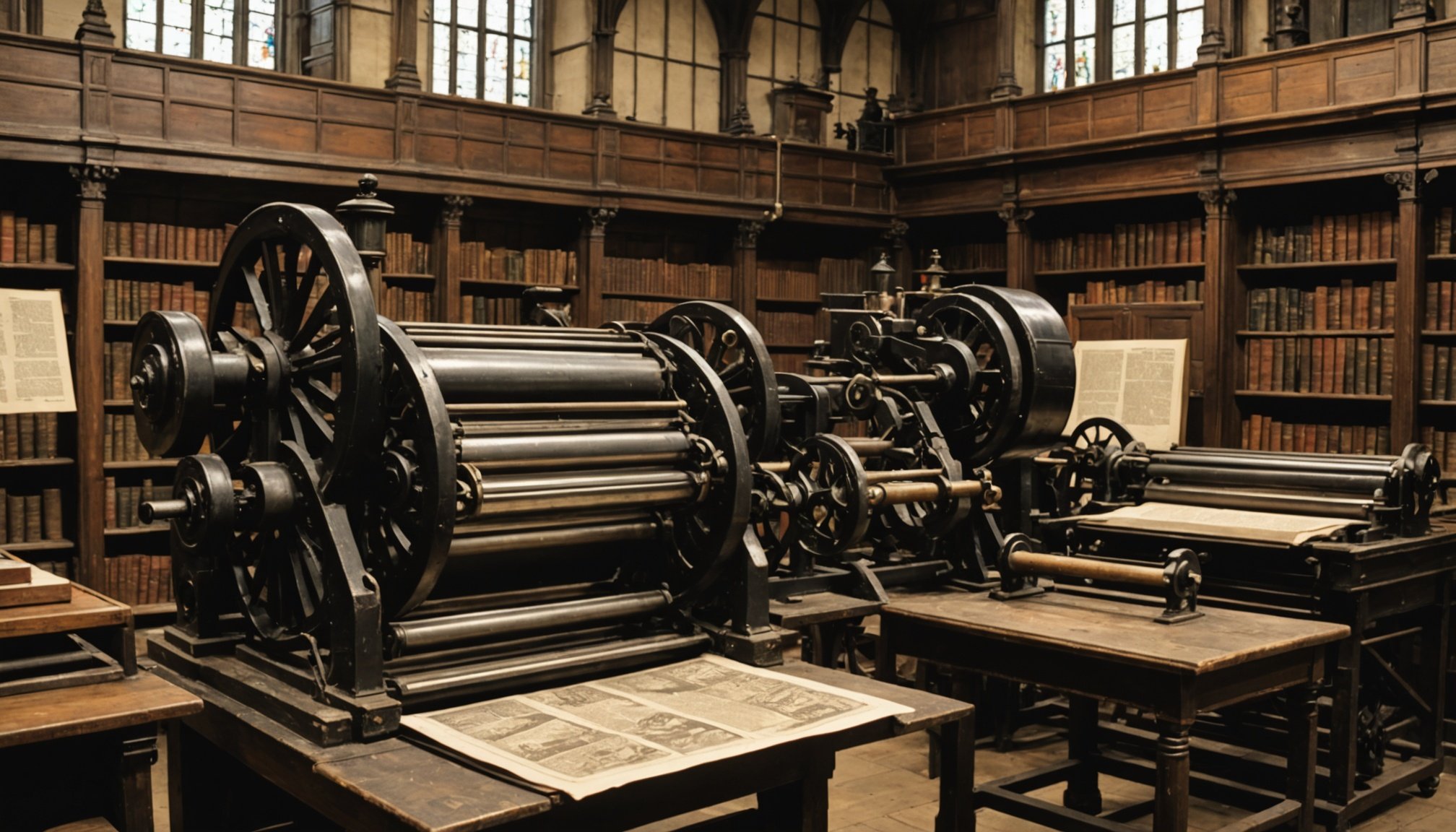Overview of British Printing History
Understanding the significance of printing in British history necessitates exploring its evolution and impact. In the early years, the printing revolution began in the late 15th century with William Caxton, who introduced the first printing press to England around 1476. This pivotal moment marked a shift in how information was disseminated, gradually transforming British culture and society.
Evolution of Printing Technology
British printing history witnessed substantial technological advancements over centuries. Initially, the hand-operated press dominated, but by the 19th century, mechanisation altered the landscape. The introduction of steam-powered presses enabled mass production of printed materials, making books, newspapers, and pamphlets widely accessible.
Also read : Get ready for stray kids' electrifying london concert in july 2025
Key Figures and Movements
Pioneers played a significant role in shaping British printing history. Figures like Caxton and later John Baskerville, an innovative typographer in the 18th century, contributed to the historical context by enhancing the quality and aesthetics of printed works. Movements like the Arts and Crafts Movement in the late 19th century also revitalised traditional printing techniques, focusing on craftsmanship and design.
Impact on British Culture and Society
The significance of printing extended beyond mere technological curiosity. It facilitated the diffusion of ideas, influencing political, religious, and cultural dialogues. By enabling widespread literacy and the exchange of information, printing nurtured democratic societies and spearheaded movements such as the Reformation and the English Enlightenment.
Additional reading : Stray kids set to ignite london in july 2025 world tour
British Museum
The British Museum showcases a remarkable collection of exhibitions, with an impressive focus on the history of printing. An essential part of their offerings includes exhibitions dedicated to the evolution of printing techniques, highlighting the impact of the printing history on society and culture. These exhibits feature an array of artifacts, such as early printed books, engravings, and printing presses, providing a fascinating glimpse into the past.
In addition to these engaging exhibitions, the museum provides a plethora of educational resources for visitors. These resources aim to enrich the visitor experience and offer deeper insights into printing history. Guided tours, interactive workshops, and educational booklets are available, making the learning experience both enjoyable and informative.
For those planning a visit, understanding the visitor information and equipped with tips can enhance your exploration of the museum. Begin with examining the layout and identifying key exhibitions you wish to explore. Plan your visit during non-peak hours to avoid crowds and maximise your time engaging with the exhibits. Utilize the museum’s app or map for a seamless navigation experience, ensuring you don’t miss any of the notable print-related exhibitions or resources the British Museum has to offer.
Museum of Printing
In the heart of the Museum of Printing, visitors can dive into a world where traditional printing techniques come alive. Exhibits at this unique museum showcase everything from the historic Gutenberg press to the more modern lithographic processes, providing a detailed journey through the evolution of printed media. This deep exploration allows attendees to appreciate the intricate craftsmanship and technical prowess involved in each print process.
Visitors are not just passive spectators. The museum also provides numerous hands-on experiences. Interactive workshops are designed to engage and educate visitors of all ages. Participants can try their hand at setting type, operating a press, or even crafting their own printed pieces. These learning opportunities enrich understanding and appreciation for the artistry and effort behind the printed word.
Access to the museum ensures an inclusive and enjoyable experience for everyone. With its commitment to education, the Museum of Printing often hosts special events and guided tours, making sure each visitor can immerse themselves thoroughly. This accessible format assures that individuals can glean maximum information and enjoyment from their visit, fostering a greater appreciation for the art of print.
University of Cambridge: The Whipple Museum
The Whipple Museum at the University of Cambridge houses a remarkable array of scientific instruments and artefacts, offering unique insights into the history of printing and communication. Its extensive collection showcases the evolution of technology through time. Among the treasures are rare scientific tools that highlight the momentous intersection of printing and science, such as early microscopes and telescopes.
Unique Collection
This museum stands out due to its carefully curated exhibits, which delve into the intricate relationship between print and scientific advancement. Noteworthy pieces from its collection include early printed star maps, which were pivotal in early astronomical studies. There’s an impressive range of instruments that contributed significantly to historical scientific discoveries. For anyone passionate about the legacy of scientific communication, this museum provides an unparalleled experience.
Special Exhibits
A significant feature of the Whipple Museum is its special exhibits. These periodically focus on how printing facilitated the dissemination of scientific ideas, enhancing public comprehension of complex concepts. For instance, visitors may encounter exhibitions detailing how early printed diagrams revolutionised educational practices.
Visitor Instructions
To maximize the experience, guests are encouraged to explore interactive displays, providing a hands-on approach to science history. Notable highlights of the museum include its guided tours, which offer in-depth perspectives on its most prized collections. It’s advisable to check the museum’s opening hours and any special guidelines prior to visiting.
The Stationers’ Hall
Nestled in the heart of London, Stationers’ Hall stands as a testament to the rich history of the British publishing industry. This iconic structure has been the hub of literary and publishing activities since its establishment in the 1500s. Serving as a significant historical landmark, the Hall offers a unique window into the evolution of publishing practices over the centuries.
Stationers’ Hall is not just a relic of the past; it actively engages visitors through guided tours and themed events that delve into the intricacies of printing history. These immersive experiences allow visitors to explore ancient artifacts and understand the pivotal role the Hall played in the dissemination of knowledge.
For those planning a visit, recommendations include attending narratively-rich tours that frequently feature guest speakers who are experts in printing history. The tours provide detailed insights into the behind-the-scenes workings of the publishing world and the societal transformations that the industry has influenced.
Access to Stationers’ Hall is facilitated through both public and private tour options, ensuring a personalized experience. Reservations are advised to ensure a spot and gain the most value from this historical landmark. Do check the official website for schedule updates, as these tours and events are highly sought after.
The John Rylands Library
Tucked away in Manchester, the John Rylands Library stands as a testament to the printing heritage and the history of the printed word. Established over a century ago, this library boasts an impressive collection that celebrates the evolution of printing history. Among its treasures are thousands of rare books and manuscripts that offer a window into the past and captivate the imaginations of scholars and visitors alike.
Visitors to the library can feast their eyes on some of the world’s most significant volumes. Notable rare books include a Gutenberg Bible, one of the earliest major books printed using movable type, and a vast array of medieval manuscripts. These works not only highlight the advancements in printing technology but also the preservation of literary art over the centuries.
Guests at the John Rylands Library frequently express their awe and appreciation for the insights these collections afford. Walking through its majestic halls, visitors often note the grandeur of the architecture coupled with the timeless value of the texts encased within. The immersive experience of exploring these rare books provides a tactile connection to history, making the library a must-visit for anyone interested in the legacy of printing and literature depositories worldwide.
The Caxton Press and its Legacy
The Caxton Press, established by William Caxton in 1476, marked a momentous shift in the landscape of British print. Prior to its establishment, books in England were predominantly handwritten, limiting accessibility and dissemination. With the introduction of the printing press, Caxton revolutionised the way information was shared, enabling mass production of literature and essentially democratizing knowledge.
William Caxton’s most notable contribution through the Caxton Press was his promotion of English literature. By printing seminal works like Geoffrey Chaucer’s “The Canterbury Tales,” Caxton played a critical role in standardising the English language. His editions also preserved many early works that might otherwise have been lost to time.
The legacy of the Caxton Press extends beyond literature. Caxton was instrumental in evolving the printing technology itself, incorporating innovations that improved efficiency and quality in print production. This helped position England as a prominent player in the European printing revolution.
Anecdotal evidence reveals that Caxton’s dedication to his craft extended into his daily life. He would engage with local scribes and academics to cultivate a rich printing culture in Westminster, enriching the visitor experience to the printing house. Overall, the Caxton Press stands as a testament to the enduring impact of print in society.
Practical Tips for Exploring Printing History in the UK
For enthusiasts eager to delve into British printing history, planning a rewarding journey involves a thoughtful itinerary. Consider travel tips that leverage proximity, allowing you to visit multiple historical sites efficiently. Start by exploring the Library of Birmingham, which often hosts printing and book history exhibitions. From there, a train journey can swiftly take you to the British Library in London, home to the British Printing Archive.
Ensuring accessibility for all travelers is crucial. Many historical sites in the UK are equipped with ramps and lifts, but checking each museum’s official accessibility information before visiting is wise. Doing so can aid in planning a comfortable and inclusive experience.
To enrich your exploration, these key tips are invaluable: Engage with interactive exhibits and take part in guided tours. They often provide deeper insights into how printing evolved throughout the centuries. Don’t overlook attending any workshops offered, which can provide hands-on experiences illustrating ancient printing techniques.
By thoughtfully crafting your itinerary with these travel tips, you’ll ensure a fulfilling venture into the rich tapestry of British printing history. The cultural wealth and technological milestones unearthed will undeniably leave a lasting impression.













